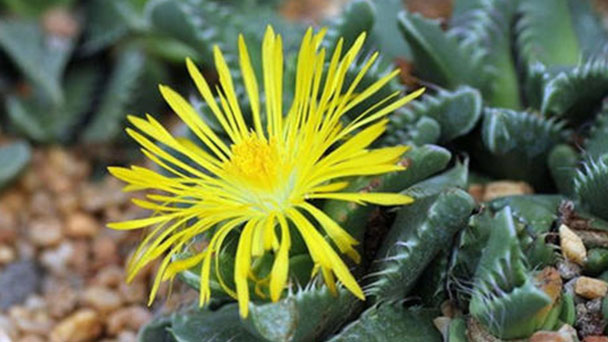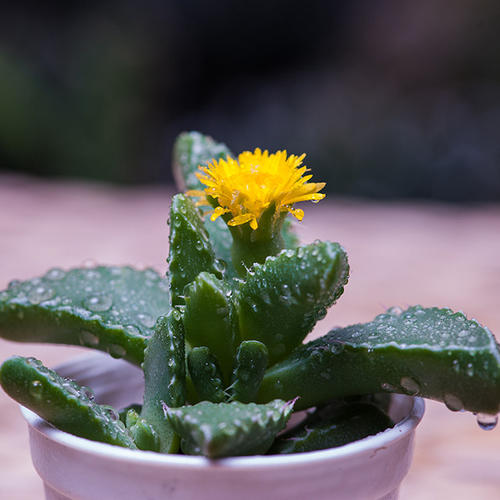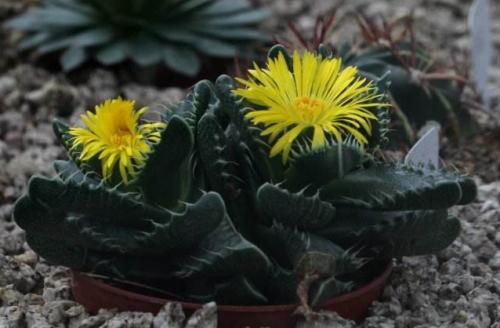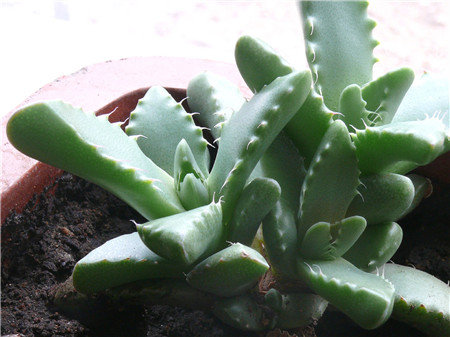Tiger Jaws Profile: Plant Facts & Care Guide
Written by Maggie
Nov 03 2021

Tiger Jaws, scientific name Faucaria tigrina, is a succulent plant of the genus Chrysanthemum in the family Pyrimonidae. Tiger Jaws is pleasant to warm and avoid heat, cold, summer dormancy, need shading 50%, frequently spray water and control watering, rain or watering more perishable. Autumn and winter growing seasons need adequate light and proper fertilizer. The leaf shape and color are beautiful and have certain ornamental values. Potted Tiger Jaws can be placed in the TV, computer, can absorb radiation, can also be planted in the room to absorb formaldehyde and other substances, purify the air.
Tiger Jaws Plant Picture

Tiger Jaws Plant Characteristics
Tiger Jaws (Faucaria tigrina) is densely clustered, very fleshy, cross opposite, base united, apex triangular, epidermis of leaf margin and dorsal keel process is hard, most leaves have fleshy teeth. The leaf margin of Tiger Jaws has fleshy coarse cilia, flowers are large and sessile, flowers are mostly yellow, dormant in summer.
Tiger Jaws Plant Growth Habit
Tiger Jaws likes warm and avoid hot summer, cold, dormant in summer, and it needs appropriate shade, frequently spray water and control watering, rain or watering more perishable. Autumn and winter tiger jaws growing seasons need adequate light and proper fertilizer. Tiger Jaws can be successfully maintained as long as the links of water control, ventilation, shading and fertilizer stop are well mastered in the dormant period of summer.
Tiger Jaws Plant Care
Tiger Jaws Soil Requirements
Tiger Jaws can be used in small pots. The soil is usually sandy with good drainage and ventilation.
Tiger Jaws Light Requirements
Tiger Jaws plant needs sufficient sunlight. Full sunlight should be given during curing, especially in autumn and winter. Sufficient sunlight is conducive to the growth of Tiger Jaws. But in summer, high temperature weather, to avoid exposure to the sun, the appropriate shading, shading area is about 50%.
Tiger Jaws Watering
Tiger Jaws likes a dry environment, and it is very sensitive to water, and needs sufficient fat water during the growth period. In the summer dormant period, it is necessary to moderate watering, spray more water to the leaf surface, avoid the rain, and water is not too much, which will lead to rot of Tiger Jaws.
Tiger Jaws Temperature Care
The optimum growth temperature of Tiger Jaws is between 18 ℃ and 24℃. Tiger Jaws is dormant and stops growing during high summer temperatures. In a high temperature environment, to cool down heat dissipation. Tiger Jaws can withstand the low temperature between -5 and 0℃, but the winter overwintering temperature should be above 15℃, especially in northern China, Tiger Jaws should be put indoors for maintenance in winter, pay attention to cold insulation.
Tiger Jaws Humidity Care
Tiger jaws succulent likes to be dry, and the relative humidity should be kept below 50%, but usually below 40%. Do not put Tiger Jaws on air conditioning radiators in northern areas in winter.
Tiger Jaws Fertilizer
Tiger Jaws does not require much fertilizer, as long as appropriate fertilizer water is applied on a regular basis.

Tiger Jaws Plant Propagation
Tiger Jaws (Faucaria tigrina) is a succulent plant of Pseudomania family. The plants are densely clumped. The most simple and quick way to propagate Tiger Jaws is to propagate by planting.
The propagate method of tiger jaws succulent is mainly plant division, and it is best to carry out in spring and autumn. Tiger Jaws succulent is multiplied by splicing. Like other succulent plants, Tiger Jaws is uprooted, robust plants are selected for splicing, cut into several plants, and then transplanted.
Tiger Jaws Plant Uses
Tiger Jaws succulent is potted for windowsills, bedrooms, balconies or case a few embellishments; Also Tiger Jaws is applicable to the layout of desert special class gardens.

Latest Updated
- Benefits of Bugleweed - 7 Science-backed Health Benefits
- Bugleweed Dangers & Side Effects - Is It Poisonous?
- How to Plant Evergreen Trees - What You Should Know
- When to Plant Evergreens - Grow Guide for Evergreen Trees
- 12 Wonderful Evergreen Shrubs for Your Garden
- 12 Popular Evergreen Plants with Pictures for Beginners
- When And How To Prune A Lilac Bush Like a Pro
- How to Grow & Care for Lilac Vine (Hardenbergia Violacea)
- Japanese Lilac Tree (Syringa Reticulata) Care & Propagation Guide
- Shumard Oak Pros and Cons - What to Know
Popular Articles
- Winter maintenance of Antirrhinum Majus
- How to Grow Terminalia Mantaly Tree
- How to Grow and Care for Crossostephium Chinense
- How to grow Antirrhinum Majus in spring
- Peristeria Elata (Dove Orchid) Profile: Info & Care Guide
- Underwatered Snake Plant (Sansevieria Trifasciata) - Signs And How To Fix
- How to Care for Brazilian Jasmine Plant (Mandevilla Sanderi)
- How to Grow & Care for Graptopetalum Purple Delight in Summer
- Rosa Chinensis (China Rose): Plant Growing & Care Tips
- How to Care for Baby Sun Rose (Aptenia Cordifolia)